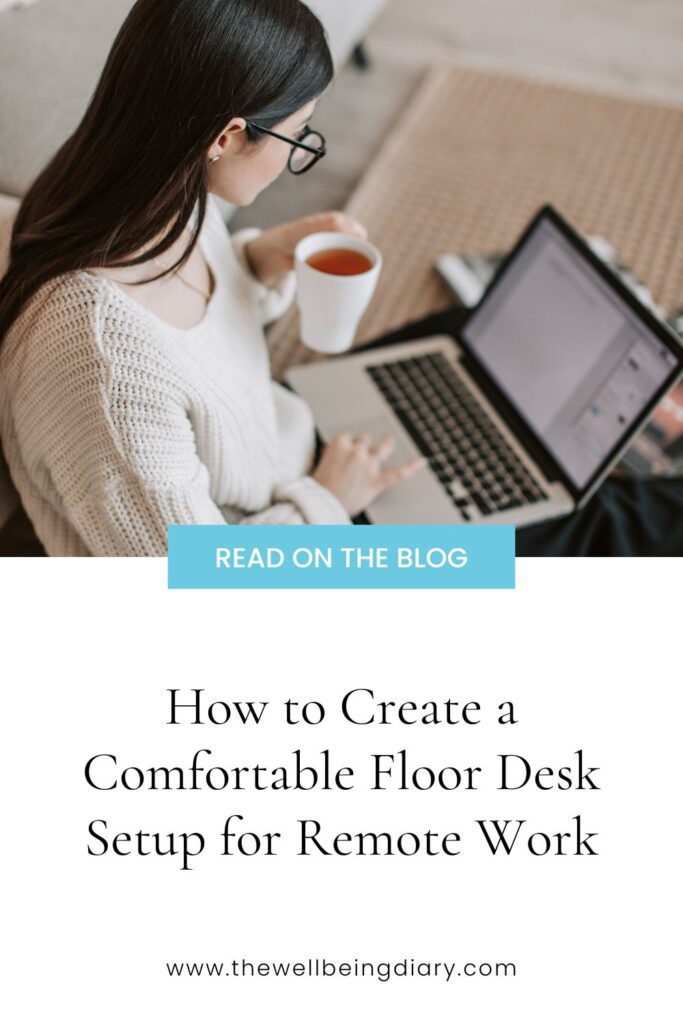How to Create a Comfortable Floor Desk Setup for Remote Work

Disclaimer: This post contains Amazon affiliate links. As an Amazon Associate, we earn from qualifying purchases at no extra cost to you. Your support helps keep this site running. Thank you!
Key Takeaways
What are the benefits of a floor desk setup?
A floor desk setup promotes better posture, encourages movement variety, saves space, and is budget-friendly. It also creates a minimalist and calming workspace.
As remote work continues to rise, many people are rethinking their home office setups. One increasingly popular alternative is a floor desk setup, offering a flexible, space-saving, and budget-friendly way to work from home. However, maintaining remote work ergonomics and ensuring comfort while working on the floor requires some thoughtful planning. Whether you’re looking for a sit-stand alternative or embracing a more natural seating arrangement, here’s how you can create a healthy work habit with a well-designed floor office setup.
Benefits of a Floor Desk Setup
A floor office setup has several advantages beyond just saving space. Here’s why many remote workers are making the switch:
- Improved Posture Awareness: Sitting on the floor naturally encourages better desk posture compared to traditional office chairs, which often lead to slouching.
- More Movement Variety: Unlike sitting in a chair for hours, a floor desk setup allows you to shift between cross-legged working, kneeling, and stretching.
- Cost-Effective: Many floor desks are more affordable than traditional desks and ergonomic chairs.
- Aesthetic and Minimalist: A simple wellness workspace can help create a clutter-free, calming home office environment.
While the benefits are plenty, proper planning is necessary to ensure a healthy work habit and prevent discomfort. Below are essential home office tips to make your floor office setup functional and comfortable.
1. Choose the Right Floor Desk
A low or adjustable-height desk is key to a wellness workspace that promotes good desk posture. Look for a sturdy desk with enough surface area for your laptop, monitor, and any accessories you use daily. Some great options include:
- A minimalist coffee table: Ideal for laptop work and easy to integrate into small spaces.
- A height-adjustable laptop stand: Helps maintain a comfortable screen height and reduce strain on your neck.
- A Japanese-style chabudai table: Traditional and functional for a low-sitting work environment.
- A DIY option: If you prefer customization, consider repurposing a sturdy wooden plank with small risers.
2. Prioritize Ergonomic Seating
Since you’ll be sitting closer to the ground, it’s essential to maintain proper remote work ergonomics. Consider these seating options:
- A firm cushion or yoga bolster: Supports your hips and promotes spinal alignment.
- A kneeling chair or ergonomic floor chair: Provides back support while allowing natural movement.
- A folded blanket or tatami mat: Adds comfort when cross-legged working for extended periods.
- An inflatable balance cushion: Helps engage your core while maintaining mobility.
Pro Tip:
Switching positions frequently is key to preventing stiffness. Try alternating between different postures every 30-45 minutes.
3. Support Your Back and Posture
Sitting on the floor can strain your lower back, so incorporating ergonomic workstation elements is crucial:
- Use lumbar pillows or a rolled-up towel for lower back support.
- Keep your knees level with or slightly below your hips to maintain a neutral spine position.
- Lean against a sturdy wall or cushion for added support.
- Stretch regularly to release tension in your lower back and hips.
4. Optimize Your Desk Height and Screen Position
For better desk posture, make sure your screen is at eye level to prevent neck strain:
- Use a laptop stand or stack books to elevate your screen.
- If using an external monitor, place it at a comfortable viewing height to avoid looking down for long periods.
- Consider an external keyboard and mouse for better arm positioning and reduced wrist strain.
Adjusting for Optimal Viewing Angle:
- Your monitor should be at arm’s length away with the top of the screen at eye level.
- Your wrists should remain neutral while typing to prevent strain.
5. Incorporate Movement and Stretching
One of the benefits of a floor office setup is the ability to change positions easily. Encourage healthy work habits by:
- Shifting between cross-legged, kneeling, and sitting with legs extended.
- Taking breaks to stretch your hips, back, and legs every hour.
- Standing up periodically to promote circulation and reduce fatigue.
- Using a foam roller or massage ball to release tension in tight areas.
Desk-Friendly Stretches:
- Seated spinal twist: Helps relieve back stiffness.
- Butterfly stretch: Loosens up the hips.
- Forward fold: Stretches the lower back and hamstrings.
6. Add Comfort and Warmth
To make your home office cozy and inviting:
- Use a soft but firm rug or tatami mat to cushion your workspace.
- Keep a blanket nearby for warmth in colder months.
- Adjust lighting to reduce eye strain, ideally with soft, natural light.
- Keep a water bottle close by to stay hydrated throughout the day.
7. Consider a Sit-Stand Alternative
If you want more variety in your work setup, try integrating a sit-stand alternative:
- Work at a low table for some tasks and switch to a standing setup occasionally.
- Use a balance cushion to engage your core while sitting.
- Set up a standing desk converter on a raised surface when needed.
8. Maintain a Clean and Organized Space
A clutter-free floor office setup can enhance focus and productivity. Keep your space organized with:
- A small storage box or basket for essential work tools.
- Cable management solutions to prevent tangled cords.
- Minimal but functional decor to keep your workspace aesthetically pleasing and distraction-free.
Final Thoughts
Creating an ergonomic workstation on the floor is all about balance—supporting your body while allowing for movement and flexibility. By choosing the right desk, seating, and wellness workspace essentials, you can enjoy a comfortable and productive floor desk experience.
With these home office tips, you’ll be well on your way to a healthier, more adaptable remote work setup! Whether you’re looking for a sit-stand alternative or simply a new way to stay engaged while working from home, a floor office setup can be a great solution when done correctly.
Are you considering switching to a floor desk setup? Let us know your experience and tips in the comments!
FAQ
Is a floor desk setup good for posture?
Yes! Sitting on the floor encourages better posture awareness and natural spinal alignment, reducing slouching compared to traditional office chairs.
What type of floor desk should I use?
A sturdy, low-height desk or adjustable laptop stand works best. Options like a chabudai table, coffee table, or DIY setups can fit different needs.
How can I make sitting on the floor more comfortable?
Use firm cushions, yoga bolsters, ergonomic floor chairs, or tatami mats to support your hips and spine. Changing positions regularly also helps prevent stiffness.
How do I keep my screen at eye level with a floor desk?
Elevate your laptop with a stand or stack of books, and use an external keyboard and mouse for better ergonomics. A monitor at arm’s length is ideal.
What are the best stretches for a floor office setup?
Try seated spinal twists, butterfly stretches, and forward folds to keep your back, hips, and legs flexible and pain-free during long work sessions.

